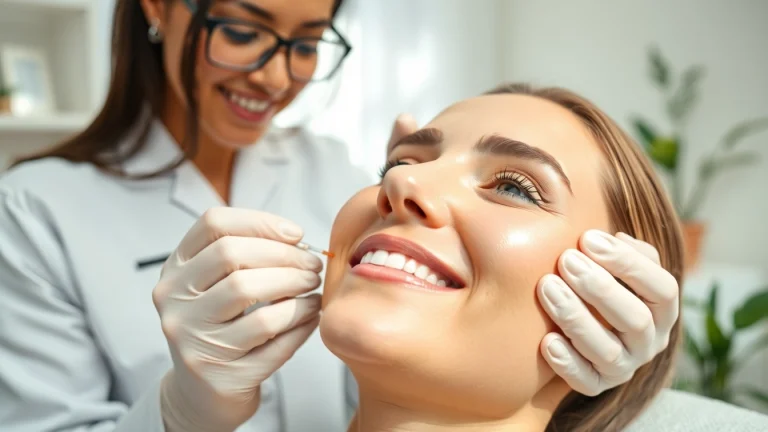
The Comprehensive Guide to Face Fillers: Types, Benefits, and Safety
Understanding Face Fillers
What Are Face Fillers?
Face fillers, often referred to as dermal fillers, are injectable substances primarily used to rejuvenate and enhance the features of the face. These fillers are designed to add volume, smooth out wrinkles, and restore youthful contours, providing a non-surgical option for facial rejuvenation. Typically composed of various substances, including hyaluronic acid and collagen, these fillers essentially help counteract the effects of aging and environmental factors that lead to skin laxity and volume loss.
In recent years, the popularity of face fillers has surged, driven by their immediate results, minimal downtime, and the increasing societal acceptance of cosmetic enhancements. Unlike surgical procedures, these injectables can be administered in a relatively short amount of time, making them attractive to those seeking quick improvements without the commitment of more invasive surgeries.
How Do Face Fillers Work?
Face fillers work by introducing specific substances beneath the skin to enhance volume where it is lacking. The main action involves filling in areas of the face that have lost volume due to aging or other factors. These fillers can plump lips, soften facial folds, and restore a youthful plumpness to cheeks and temples.
Depending on the type of filler used, the results can vary. For instance, hyaluronic acid fillers draw water to the injected area, resulting in increased volume and hydration. The effects of face fillers can last anywhere from a few months to over a year, depending on the formulation and area treated.
Common Uses of Face Fillers
The applications for face fillers are diverse, with some of the most common uses including:
- Facial volume restoration: As we age, certain areas of our face may start to sag or flatten. Fillers can rejuvenate these areas, restoring lost volume and smoothing out contours.
- Wrinkle reduction: Facial fillers can effectively reduce the appearance of static wrinkles and lines by filling in the treated areas, making them less noticeable.
- Lip enhancement: One of the most celebrated uses of face fillers is in lip augmentation, creating fuller, more defined lips.
- Cheek enhancement: Fillers can add volume and lift to the cheeks, resulting in a more youthful appearance.
- Temples and jawline definition: Restoring volume in the temples and enhancing the jawline can create a more balanced and youthful face.
Types of Face Fillers
Hyaluronic Acid Fillers
Hyaluronic acid fillers are among the most popular types of face fillers. Hyaluronic acid (HA) is a naturally occurring substance in the body, known for its ability to retain moisture. When injected, HA fillers can effectively plump skin and reduce the appearance of wrinkles and fine lines.
Examples of HA fillers include Juvederm and Restylane. These products vary in viscosity and are formulated for specific purposes, allowing practitioners to choose the right product for each area of the face.
Collagen-Based Fillers
Collagen-based fillers mimic the body’s natural collagen, providing structure and support to the skin. Traditionally popular, collagen fillers have seen a decline due to the emergence of more effective options, such as hyaluronic acid fillers. However, they can still be beneficial for patients seeking a more natural enhancement, particularly in areas like the lips and nasolabial folds.
Fat Transfer Fillers
Fat transfer, also known as fat grafting, involves harvesting fat from another area of the patient’s body (such as the abdomen or thighs) and injecting it into the face. This method is particularly appealing for individuals seeking a natural look, as the body does not recognize the transferred fat as foreign. Fat transfer fillers can provide long-lasting results, though it may require more downtime because of the liposuction process.
Benefits of Face Fillers
Immediate Results
One of the standout advantages of face fillers is the immediate results they deliver. Patients often leave the clinic with visible improvements instantly, and these effects can be especially gratifying in contrast to more invasive surgical procedures, which can take weeks for swelling to subside and full results to be observed.
Non-Invasive
Since face fillers are non-surgical, they typically come with less risk than surgical alternatives. There’s usually no need for anesthesia, and the procedure can often be completed in less than an hour. This accessibility eliminates extended recovery times, making it feasible for busy individuals to fit treatment into their schedules.
Customizable Treatments
Face fillers can be tailored to meet the specific needs of each patient. Practitioners can select from various types of fillers and adjust the amount used to achieve the desired outcome. This level of customization ensures that patients achieve results aligned with their personal aesthetic goals, thus enhancing satisfaction.
Potential Risks and Side Effects
Common Side Effects
While face fillers offer numerous benefits, patients should be aware of potential side effects. Common reactions include redness, swelling, bruising, and tenderness at the injection site. These side effects typically subsided within a few days and are generally minimal.
Long-Term Considerations
Though the risks are relatively low for most patients, long-term considerations should not be overlooked. Some individuals may experience lumps or unevenness following treatment. In rare cases, vascular occlusion can occur, where filler material unintentionally enters a blood vessel, leading to serious complications.
Consultation and Preparation
Prospective patients should undergo a thorough consultation before treatment to discuss their specific concerns and expectations. A medical history evaluation is crucial, as certain conditions and medications may increase the risk of complications. Preparation may also involve avoiding blood-thinning medications and substances, which can minimize bruising and swelling.
Choosing the Right Provider for Face Fillers
Qualifications to Look For
Selecting a qualified provider for face fillers is paramount to achieving safe and satisfying results. Look for a licensed and experienced practitioner, ideally a board-certified dermatologist or plastic surgeon. It’s also essential that they have a proven track record of performing injectable treatments.
Questions to Ask Before Treatment
Before proceeding with face fillers, patients should not hesitate to ask questions. Key inquiries may include:
- What type of fillers do you recommend for my specific needs?
- How much experience do you have with these procedures?
- What side effects should I expect, and how are complications managed?
- Can you share before-and-after photos of previous patients?
Post-Treatment Care and Maintenance
After treatment, patients should follow specific post-care instructions to ensure optimal results. This may include avoiding vigorous exercise, excessive sun exposure, and alcohol consumption for a few days. Regular follow-ups may be necessary to assess the longevity of the fillers and determine if touch-ups are required for maintaining results.


